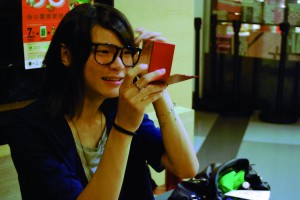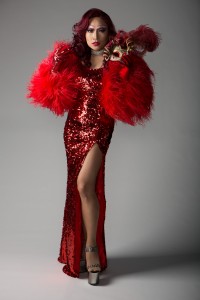However, like many other cross-dressers, Wong does not dare to buy women’s clothes in boutiques, out of fear that she will be stared at and insulted.
Apart from online shopping, Wong says there are strategies to cope with these situations. For example, she would pretend to be buying clothes for a girlfriend, for a drama performance or for her course work as a fashion student.
Going to the washroom is another problem. Wong says it is embarrassing for her to enter the men’s toilet in women’s dress. When she does, she is often scolded loudly by the astonished men in the toilet.
Wong’s experiences are shared by Jaco Fok Chi-hin, another male cross-dresser. Fok, who is 22, first cross-dressed in public when he took part in a magic show at university a year ago.

Fok says he is often glared at by passers-by when he is walking in the street. “A stare may be more disturbing than a word,” he says.
And unlike Wong, Fok tries not to let his mother see him dressed as a woman, even though he has told her in the past that he wants to be a girl. Instead, he often goes home at midnight when his mum is already asleep. “I believe that she cannot completely accept it, but at least I feel happy that she tries to understand.’’
Wong and Fok may find varying degrees of disapproval from mainstream society for cross-dressing in daily life, but society seems to be more accepting of men dressed as women in the context of “drag”. Drag is a performance in which a man cross-dresses and acts in an exaggerated manner.
Cross-dressing and drag are often lumped together but while they share some similarities, there are also differences.
Bryan Chan, the 41-year-old owner of a production company, sometimes transforms himself into a glamourous singer and drag queen, Coco Pop.
Back in 2002, Bryan was invited by his friends to join a drag performance competition in a bar. Unexpectedly, he was picked as the first-runner up despite his slapdash makeup and choice of costumes. Since then, Chan has firmly believed he was born to be a drag queen.
Chan says that unlike cross-dressing, drag is about the business of entertaining audiences. Drag queens seek and thrive on the attention – the audience’s screams, admiration and compliments delight them.
As doing drag is a performance rather than a daily-life practice, drag queens dress in a more flamboyant and extravagant style than cross-dressers do. They pay close attention to styling, hair and make-up. Chan says it can take him up to six hours to complete his look. For events like Halloween, drag queens may prepare their outfits a week beforehand.

(Courtesy photo from Bryan Chan)
To achieve perfection, Chan designs his own costumes and sometimes uses several hairpieces together. He says performing in drag empowers him, it releases the qualities hidden deep in his heart – the desire to rebel and dominate.
Whether it is everyday cross-dressing or drag, the impulse to cross gender boundaries is a form of expression. And for Jaco Fok it is a kind of expression that is more frowned upon when it is adopted by men than when it is adopted by women.
Fok says female cross-dressers are by and large better accepted by society than male ones. He attributes this to traditional patriarchal Chinese culture where men have higher social status and are subject to more rigid expectations than in societies where men and women are more equal.
Joseph Cho Man-kit, a lecturer of the Gender Studies Programme at the Chinese University of Hong Kong, relates the phenomenon to the gender hierarchy. Since men have a more prestigious status in society, females acting in a masculine way are considered to be moving up in the hierarchy. Whilst for a male to dress in a feminine way is considered a demotion, giving rise to the conception that cross-dressing is deviant.






































